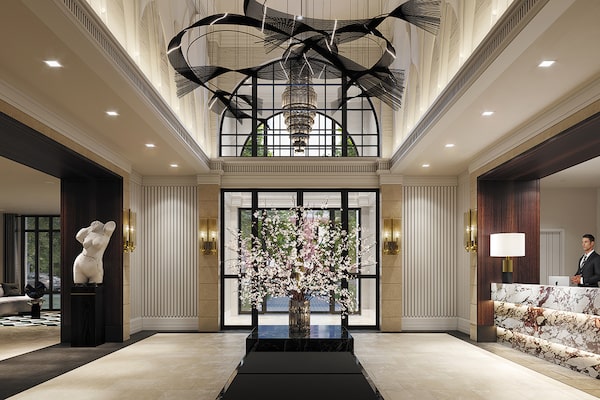
The lobby at Maison 77 Clarendon. According to veteran art consultant Fela Grunwald, “art becomes a signature of the building.”Menkes Developments
Sculptures, paintings, installations reflect a developer’s values, says art consultant
It could be hand-carved birch sculptures in the lobby of a luxury lakeshore property that suggest the billowing sails of a boat. Or perhaps it’s a gleaming golden ripple, made from rows of aluminum blocks, that adds some serious bling to the façade of a sleek tower in Toronto’s downtown core.
The art that adorns the public spaces of upscale condominiums may not be considered an amenity in the conventional sense, like a fitness facility or a rooftop terrace. But it’s far more than just decoration.
“Art adds character to a great development,” says art consultant Grace Zeppilli, whose company GZ Art Co. has provided artworks for buildings from Toronto and Vancouver to New York and Las Vegas. Her GTA condo projects include sail-themed sculptures for the Pier 27 residences on Queens Quay, which were commissioned from Ontario artist Rod Mireau.
Currently, she’s planning the art for No. 7 Dale, the new development by Platinum Vista Ltd., in Toronto’s old-monied Rosedale neighbourhood. It will include a commissioned sculpture for the garden at the front entrance.
Zeppilli is aiming for a piece of art that will give condo owners a feeling of being welcomed home. “I want them to feel like they’re arriving in this decompression zone,” she explains, “with this beautiful sculpture that’s calming and has a sense of luxury and place.”
Zeppilli says art should always complement the vision of the building’s designers, which could even include using the same construction materials.
For No. 7 Dale, she’s collaborating with the first-class team of architect Siamak Hariri, landscape architect Janet Rosenberg and interior designer Alessandro Munge. “I’m working with them to make sure the piece of art is speaking their language,” she says.

Artwork and dramatic lighting add character to the lobby of 89 Avenue Yorkville.Armour Heights Developments
Sometimes the art itself will influence the design of the building, as in the case of Aura at College Park. The two-storey, glass-enclosed entryway of the soaring condo tower, a Canderel Stoneridge development, was conceived as a gallery space. Step into it and you’re confronted with a pair of striking works by Canadian artists: City Dancing in the Night, a vast, vibrant abstract painting by Toronto artist Janna Watson, dominates the inner wall, in conversation with the facing The Faults in Three Quarters, a huge, silvery aluminum sphere by Quebec sculptor Marc-Antoine Côté.
While some art is intended purely for the pleasure of residents and guests, there are also the big outdoor works meant to be enjoyed by the general public. Under Section 37 of Ontario’s Planning Act, any private development in Toronto that increases a neighbourhood’s density must devote 1 per cent of its gross construction costs to public art.
That stipulation has resulted in some eye-catching pieces, such as Matt Donovan’s Digital Wave, the golden relief sculpture affixed to the Fleur Condos tower at Shuter and Church streets. More than seven metres high and two metres wide, it’s an outsized version of the intricate Lego-built works that Toronto artist Donovan is known for.
Veteran art consultant Fela Grunwald, who oversaw the Fleur artwork for developer Menkes, says such pieces are a win-win for both the developer and the artist. “The art becomes a signature of the building,” she says, while the commission gives an artist the opportunity to work on a large scale. “A lot of them have the desire to make these monumental pieces but can’t afford it,” she says. “This allows them to do it and expand the range of their work.”
Creating art for public areas is also a great means of exposure for the artist, Zeppilli adds. “They get commissions on their own as a result.”
Most public art is commissioned, but existing work will sometimes be acquired for condo interiors. Zeppilli says she likes to use a wide variety of artists and is always scouting galleries and art shows. The pickings in Toronto are rich, she says. “People don’t realize the plethora of good art in this city.”
Developers have come to appreciate that, says Grunwald, who has been facilitating public art since the 1990s, when it became part of the Planning Act. “A lot of them, having seen how it’s impacted the city, are no longer as averse as they once were,” she notes. Some, such as the Menkes family, have even made it a hallmark of their developments. “They have an appreciation of art and value it,” Grunwald says.
That speaks to the potential condo resident, Zeppilli adds. “It says of the developers, ‘These guys really cared about this environment, they have put a lot of thought into it.’ Art creates this message that this is more than just a building; that it has soul to it.”
Advertising feature produced by Globe Content Studio. The Globe’s editorial department was not involved.